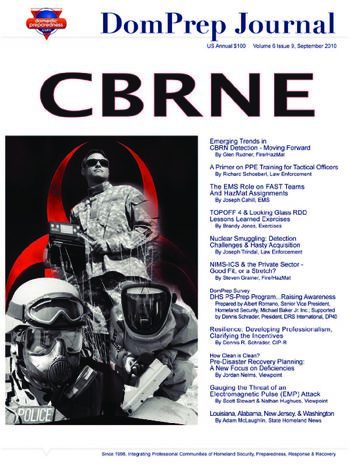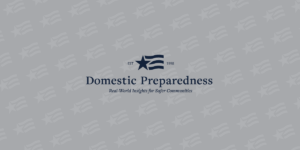

Emerging Trends in CBRN Detection – Moving Forward
Glen Rudner
September 29, 2010
The goal is clear: to protect the U.S. homeland from CBRN attacks today, tomorrow, and far into the future. But the race – against an implacable enemy – is endless, there are numerous gaps and pitfalls blocking the way forward, and the winner may not necessarily be the runner who is the best trained and equipped but the one who is the most determined.

Pre-Disaster Recovery Planning: A New Focus on Deficiencies
Jordan Nelms
September 22, 2010
Earlier this month – more specifically, on 11 September – the United States observed the ninth anniversary of the most devastating terrorist attack in the nation’s history; the occasion was

Nuclear Smuggling: Detection Challenges & Hasty Acquisition
Joseph W. Trindal
September 22, 2010
The Department of Homeland Security’s Customs & Border Protection branch has several immensely important responsibilities. There is no other challenge, though, quite so daunting as its primary duty of keeping nuclear weapons and/or devices from entering any of the more than 300 U.S. ports of entry from overseas. Making that task even more difficult, unfortunately, are a number of major cost, technological, and bureaucratic complications.

NIMS-ICS & the Private Sector – Good Fit, or a Stretch?
Stephen Grainer
September 22, 2010
Nine years later, and nothing has changed! Well, that is not exactly true. The U.S. Department of Homeland Security is alive and, although not always moving forward at flank speed, has made considerable progress in several ways. Many relatively new programs should be expanded and upgraded, though, particularly those involving state and local jurisdictions – and the private sector.

Resilience: Developing Professionalism, Clarifying the Incentives
Dennis R. Schrader
September 15, 2010
The QHSR, the BUR, NFPA, and PS-Prep are marching in lockstep in their combined efforts to upgrade the nation’s awareness of resilience as a primary goal of preparedness planning, training, and implementation. Here are some helpful guidelines that political decision makers, budget managers, and operating professionals alike might find useful in developing their own resilience and business-continuity plans and policies.

A Primer on PPE Training for Tactical Officers
Richard Schoeberl
September 15, 2010
Personal Protective Equipment, particularly and specifically including PPE clothing, provides
excellent but not 100 percent guaranteed safety against the CBRNE weapons and devices that are the
terrorists’ weapons of choice in today’s increasingly dangerous world. But using PPE properly and
effectively takes both time and training, and can add significantly to the “cost of doing business.”

DomPrep Survey: PS-Prep, Is It Relevant
Domestic Preparedness
September 15, 2010
In this latest Survey, DomPrep asked members of the “DomPrep40” about the relevance – to their own
programs and professional communities – of the so-called PS-Prep (Public Sector Preparedness) program
mandated and authorized under Public Law 110-53. Here is a brief summary, by Albert Romano, of the
sometimes surprising answers provided by members of the DomPrep40. Readers are hereby invited to expand
upon and augment the DP40 answers by providing their own comments, questions, and recommendations. Take
the Survey Now!

Gauging The Threat of an Electromagnetic Pulse (EMP) Attack
Scott Stewart and Nathan Hughes
September 15, 2010
Among the various threats to the safety and security of a nation, an electromagnetic pulse (EMP)
attack should not be overlooked. The potential threat of an EMP attack has been recognized since the
early 1960s, but the growing debate surrounding this possibility parallels modern civilizations’ growing
dependency on electronics and the electrical grid. Thus the possibility of this type of attack has more
far-reaching and devastating effects than in past decades. Stratfor Global Intelligence presents this
compelling article about EMP attacks as well as possible scenarios and effects.

The EMS Role on FAST Teams & HazMat Assignments
Joseph Cahill
September 1, 2010
The risks may be theoretically “controlled” but they are still risks – and controls don’t always work. Which is the reasoning behind the “two-in/two out” rule, the need for an EMS specialist on scene, and the ethical imperative guiding the decisions of political leaders and emergency managers.

TOPOFF 4 & Looking Glass RDD Lessons Learned
Brandy Jones
September 1, 2010
There are still many important lessons to be learned from the massive “Looking Glass” tabletop exercise carried out almost three years ago just a dirty-bomb’s throw from downtown New York City. Here is a quick and easy primer on some of the most important of those lessons.

